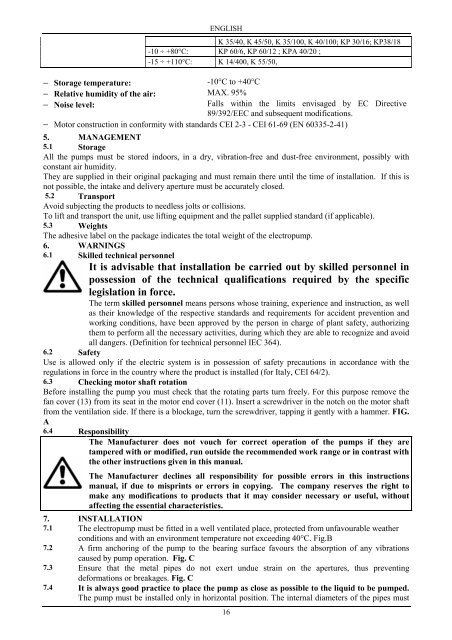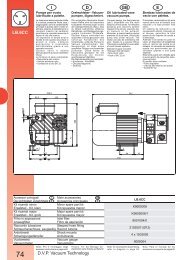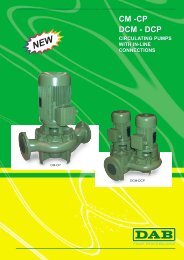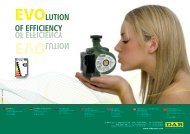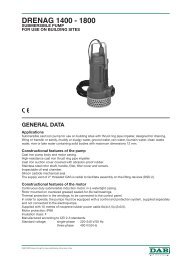Create successful ePaper yourself
Turn your PDF publications into a flip-book with our unique Google optimized e-Paper software.
ENGLISH<br />
K 35/40, K 45/50, K 35/100, K 40/100; KP 30/16; KP38/18<br />
-10 ÷ +80°C: KP 60/6, KP 60/12 ; KPA 40/20 ;<br />
-15 ÷ +110°C: K 14/400, K 55/50,<br />
− Storage temperature:<br />
-10°C to +40°C<br />
− Relative humidity of the air:<br />
MAX. 95%<br />
− Noise level:<br />
Falls within the limits envisaged by EC Directive<br />
89/392/EEC and subsequent modifications.<br />
− Motor construction in conformity with standards CEI 2-3 - CEI 61-69 (EN 60335-2-41)<br />
5. MANAGEMENT<br />
5.1 Storage<br />
All the pumps must be stored indoors, in a dry, vibration-free and dust-free environment, possibly with<br />
constant air humidity.<br />
They are supplied in their original packaging and must remain there until the time of installation. If this is<br />
not possible, the intake and delivery aperture must be accurately closed.<br />
5.2 Transport<br />
Avoid subjecting the products to needless jolts or collisions.<br />
To lift and transport the unit, use lifting equipment and the pallet supplied standard (if applicable).<br />
5.3 Weights<br />
The adhesive label on the package indicates the total weight of the electropump.<br />
6. WARNINGS<br />
6.1 Skilled technical personnel<br />
It is advisable that installation be carried out by skilled personnel in<br />
possession of the technical qualifications required by the specific<br />
legislation in force.<br />
The term skilled personnel means persons whose training, experience and instruction, as well<br />
as their knowledge of the respective standards and requirements for accident prevention and<br />
working conditions, have been approved by the person in charge of plant safety, authorizing<br />
them to perform all the necessary activities, during which they are able to recognize and avoid<br />
all dangers. (Definition for technical personnel IEC 364).<br />
6.2 Safety<br />
Use is allowed only if the electric system is in possession of safety precautions in accordance with the<br />
regulations in force in the country where the product is installed (for Italy, CEI 64/2).<br />
6.3 Checking motor shaft rotation<br />
Before installing the pump you must check that the rotating parts turn freely. For this purpose remove the<br />
fan cover (13) from its seat in the motor end cover (11). Insert a screwdriver in the notch on the motor shaft<br />
from the ventilation side. If there is a blockage, turn the screwdriver, tapping it gently with a hammer. FIG.<br />
A<br />
6.4 Responsibility<br />
The Manufacturer does not vouch for correct operation of the pumps if they are<br />
tampered with or modified, run outside the recommended work range or in contrast with<br />
the other instructions given in this manual.<br />
7.<br />
The Manufacturer declines all responsibility for possible errors in this instructions<br />
manual, if due to misprints or errors in copying. The company reserves the right to<br />
make any modifications to products that it may consider necessary or useful, without<br />
affecting the essential characteristics.<br />
INSTALLATION<br />
7.1 The electropump must be fitted in a well ventilated place, protected from unfavourable weather<br />
conditions and with an environment temperature not exceeding 40°C. Fig.B<br />
7.2 A firm anchoring of the pump to the bearing surface favours the absorption of any vibrations<br />
caused by pump operation. Fig. C<br />
7.3 Ensure that the metal pipes do not exert undue strain on the apertures, thus preventing<br />
deformations or breakages. Fig. C<br />
7.4 It is always good practice to place the pump as close as possible to the liquid to be pumped.<br />
The pump must be installed only in horizontal position. The internal diameters of the pipes must<br />
16


